SBOS207C October 2001 – December 2015 PGA2310
PRODUCTION DATA.
- 1 Features
- 2 Applications
- 3 Description
- 4 Revision History
- 5 Pin Configuration and Functions
- 6 Specifications
- 7 Detailed Description
- 8 Application and Implementation
- 9 Power Supply Recommendations
- 10Layout
- 11Device and Documentation Support
- 12Mechanical, Packaging, and Orderable Information
Package Options
Mechanical Data (Package|Pins)
Thermal pad, mechanical data (Package|Pins)
- DW|16
Orderable Information
6 Specifications
6.1 Absolute Maximum Ratings
over operating free-air temperature range (unless otherwise noted) (1)| MIN | MAX | UNIT | |||
|---|---|---|---|---|---|
| Supply Voltage | VA+ | 16 | V | ||
| VA– | –16 | ||||
| VD+ | 6.5 | ||||
| Analog input voltage | 0 | VA+,VA– | V | ||
| Digital input voltage | –0.3 | VD+ | V | ||
| Operating temperature | –55 | 125 | °C | ||
| Junction temperature | 150 | °C | |||
| Lead temperature (soldering, 10 s) | 300 | °C | |||
| Package temperature (IR, reflow, 10 s) | 235 | °C | |||
| Tstg | Storage temperature | –65 | 150 | °C | |
(1) Stresses beyond those listed under Absolute Maximum Ratings may cause permanent damage to the device. These are stress ratings only, which do not imply functional operation of the device at these or any other conditions beyond those indicated under Recommended Operating Conditions. Exposure to absolute-maximum-rated conditions for extended periods may affect device reliability.
6.2 ESD Ratings
| VALUE | UNIT | |||
|---|---|---|---|---|
| V(ESD) | Electrostatic discharge | Human-body model (HBM), per ANSI/ESDA/JEDEC JS-001(1) | ±4000 | V |
(1) JEDEC document JEP155 states that 500-V HBM allows safe manufacturing with a standard ESD control process.
6.3 Recommended Operating Conditions
over operating free-air temperature range (unless otherwise noted)| MIN | NOM | MAX | UNIT | ||
|---|---|---|---|---|---|
| VA+ | Positive analog power supply | 4.5 | 15 | 15.5 | V |
| VA– | Negative analog power supply | –4.5 | –15 | –15.5 | V |
| VD+ | Digital power supply | 4.5 | 5 | 5.5 | V |
| Operating temperature | –55 | 25 | 125 | °C | |
6.4 Thermal Information
| THERMAL METRIC(1) | PGA2310 | UNIT | ||
|---|---|---|---|---|
| D (SOIC) | P (PDIP) | |||
| 16 PINS | 16 PINS | |||
| RθJA | Junction-to-ambient thermal resistance | 83 | 39.9 | °C/W |
| RθJC(top) | Junction-to-case (top) thermal resistance | 44 | 26.2 | °C/W |
| RθJB | Junction-to-board thermal resistance | 40.5 | 20.1 | °C/W |
| ψJT | Junction-to-top characterization parameter | 11.5 | 10.7 | °C/W |
| ψJB | Junction-to-board characterization parameter | 40.2 | 19.9 | °C/W |
| RθJC(bot) | Junction-to-case (bottom) thermal resistance | N/A | N/A | °C/W |
(1) For more information about traditional and new thermal metrics, see the Semiconductor and IC Package Thermal Metrics application report, SPRA953.
6.5 Electrical Characteristics
At TA = 25°C, VA+ = 15 V, VA− = −15 V, VD+ = 5 V, RL = 100 kΩ, CL = 20 pF, BW measure = 10 Hz to 20 kHz, unless otherwise noted.| PARAMETER | TEST CONDITIONS | MIN | TYP | MAX | UNIT | ||
|---|---|---|---|---|---|---|---|
| DC CHARACTERISTICS | |||||||
| Step Size | 0.5 | dB | |||||
| Gain Error | Gain Setting = 31.5 dB | ±0.05 | dB | ||||
| Gain Matching | ±0.05 | dB | |||||
| Input Resistance | 10 | kΩ | |||||
| Input Capacitance | 7 | pF | |||||
| AC CHARACTERISTICS | |||||||
| THD+N | VIN = 10 VPP, f = 1 kHz | 0.0004% | 0.001% | ||||
| Dynamic Range | VIN = AGND, Gain = 0 dB | 116 | 120 | dB | |||
| Voltage Range, Input and Output | (VA−) + 1.5 | (VA−) − 1.5 | V | ||||
| Output Noise | VIN = AGND, Gain = 0 dB | 9.5 | 13.5 | μVRMS | |||
| Interchannel Crosstalk | f = 1 kHz | –126 | dBFS | ||||
| OUTPUT BUFFER | |||||||
| Offset Voltage | VIN = AGND, Gain = 0 dB | 0.5 | 3 | mV | |||
| Load Capacitance Stability | 1000 | pF | |||||
| Short-Circuit Current | 35 | mA | |||||
| Unity-Gain Bandwidth, Small Signal | 1.5 | MHz | |||||
| DIGITAL CHARACTERISTICS | |||||||
| High-Level Input Voltage, VIH | 2 | VD+ | V | ||||
| Low-Level Input Voltage, VIL | –0.3 | 0.8 | V | ||||
| High-Level Output Voltage, VOH | IO = 200 μA | (VD+) − 1 | V | ||||
| Low-Level Output Voltage, VOL | IO = –3.2 mA | 0.4 | V | ||||
| Input Leakage Current | 1 | 10 | µA | ||||
| SWITCHING CHARACTERISTICS | |||||||
| tSCLK | Serial Clock (SCLK) Frequency | 0 | 6.25 | MHz | |||
| tPL | Serial Clock (SCLK) Pulse Width Low | 80 | ns | ||||
| tPH | Serial Clock (SCLK) Pulse Width High | 80 | ns | ||||
| tMI | MUTE Pulse Width Low | 2 | ms | ||||
| INPUT TIMING | |||||||
| tSDS | SDI Setup Time | 20 | ns | ||||
| tSDH | SDI Hold Time | 20 | ns | ||||
| tCSCR | CS Falling to SCLK Rising | 90 | ns | ||||
| tCFCS | SCLK Falling to CS Rising | 35 | ns | ||||
| OUTPUT TIMING | |||||||
| tCSO | CS Low to SDO Active | 35 | ns | ||||
| tCFDO | SCLK Falling to SDO Data Valid | 60 | ns | ||||
| tCSZ | CS High to SDO High Impedance | 100 | ns | ||||
| POWER SUPPLY | |||||||
| Operating Voltage | VA+ | 4.5 | 15 | 15.5 | V | ||
| VA– | –4.5 | –15 | –15.5 | ||||
| VD+ | 4.5 | 5 | 5.5 | ||||
| Quiescent Current | IA+ | VA+ = 15 V | 7.5 | 10 | mA | ||
| IA– | VA– = –15 V | 7.7 | 10 | ||||
| ID+ | VD+ = 5 V | 0.8 | 1.5 | ||||
| TEMPERATURE RANGE | |||||||
| Specified Range | –40 | 85 | °C | ||||
| Operating Range | –55 | 125 | °C | ||||
6.6 Typical Characteristics
At TA = 25°C, VA+ = 15 V, VA− = −15 V, VD+ = 5 V, RL = 100 kΩ, CL = 20 pF, BW measure = 10 Hz to 20 kHz, unless otherwise noted.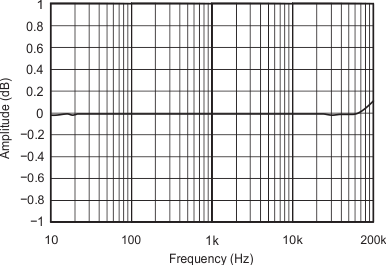
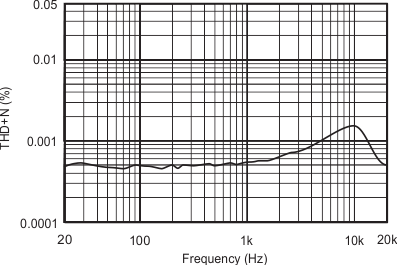
(VIN = 3 VRMS, Load = 100 kΩ)
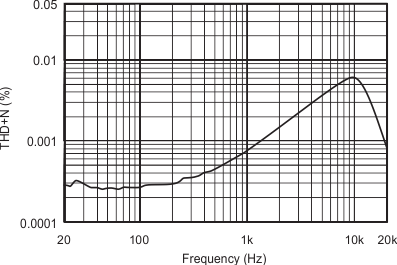
(VIN = 8.5 VRMS, Load = 100 kΩ)
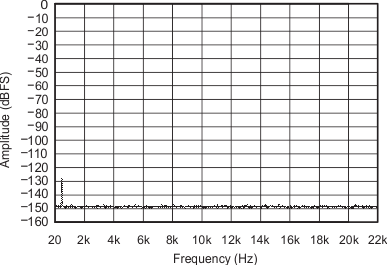
(Crosstalk With fIN = 1 kHz)
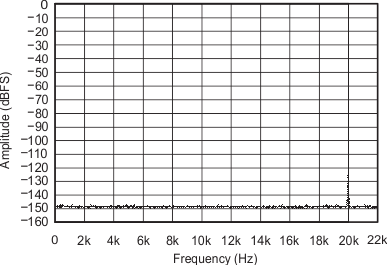
(Crosstalk With fIN = 20 kHz)
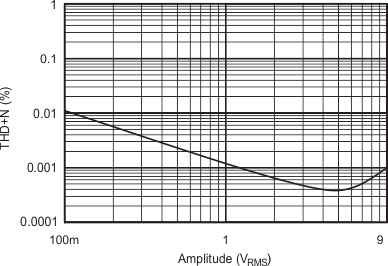
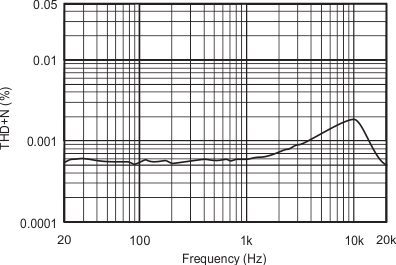
(VIN = 3 VRMS, Load = 600 kΩ)
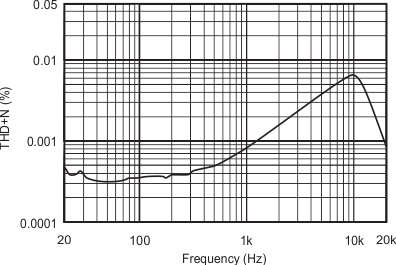
(VIN = 8.5 VRMS, Load = 600 kΩ)
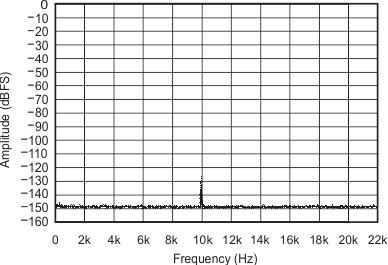
(Crosstalk with fIN = 10 kHz)